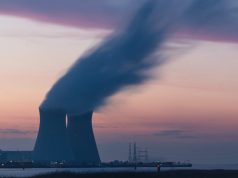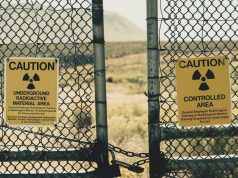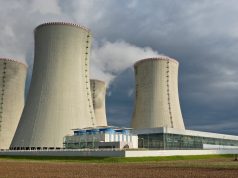INTERVIEW with David Epstein
| You recently released the report Preventing Nuclear Catastrophe: Making the Case for Investors and the Private Sector to Work Towards Reducing the Risks of Nuclear Weapons. Could you please elaborate on the key-findings?
As COVID-19 and climate change make clear, government alone cannot be counted on to protect us from catastrophe. The private sector and civil society need to be involved. And with nuclear catastrophe, which could reveal itself in an instantaneous flash one day, as opposed to a more gradual onset seen with the likes of COVID-19 and climate change, we definitely cannot wait to react until after it begins to occur.
In the report, I focus in particular on the sustainable investment community, which I believe has to make a multi-pronged effort to reduce the risks of nuclear weapons and the possibility of nuclear conflict:
〉As discussed below, ESG investors need to begin screening a range of industries for how they, sometimes in surprising ways, might be contributing to the risks of nuclear weapons/nuclear conflict. ESG investors should then engage those companies to alter behaviors in ways that might reduce the risks.
〉Impact investors, particularly those focused on investing into small and private startups, need to expand their purview to include projects that might help reduce the risks of nuclear weapons/nuclear conflict. While traditionally it has been NGO’s and various non-profit initiatives that have worked to reduce the risks of nukes, I believe that there is the potential to devise and implement some for-profit projects as well; these can appeal to impact investors, which require a financial return in addition to a social one.
〉The tools of climate and conservation finance – transition bonds, carbon cap and trade and carbon offsets, pay-for-success financing, etc. – need to be adapted and applied to some of the most intractable geopolitical problems. Because the existing toolkit is not enough.
| What can investors do to protect their portfolios from nuclear-related risks?
It is, of course, very difficult to invest specifically for the occurrence of some sort of nuclear conflict or act of terrorism involving nuclear weapons. It is impossible to know when an incident might occur – the risks compound and are significant over the longer term but the odds are not necessarily high in the short-term. It is also not knowable ahead of time what the nature of the incident will be in terms of the location and magnitude.
Particularly without knowing the timing and nature of any potential future incident, it is also very hard to predict what the market and economic effects would be. Market reactions to COVID-19 should be evidence of that; after the initial stock market volatility in the wake of lockdowns, the magnitude and speed of the stock market rebounds around the world was definitely surprising to many. Clearly fiscal and monetary policy, along with other actions by central banks and governments, had a lot to do with that resiliency. But the question remains – would central banks and governments have the same or other tools at their disposal in the future to respond to any shocks in the wake of a nuclear incident? That would depend on many factors, including the strengths of economies and government balance sheets before and immediately following any nuclear incident.
It would be poorly advised to build a portfolio that is concentrated to benefit from a nuclear incident but perform poorly in other market environments. At the same time, an overly leveraged or overly concentrated poorly could suffer catastrophic losses in the event of a nuclear incident. Therefore, I think a portfolio should just be constructed with the same diversification and other risk controls that are prudent across a range of environments – able to thrive in good times while also being able to withstand any number of shocks, whether that be a second pandemic, another financial crisis or Black Monday-type event, or a nuclear incident.
So, in addition to being highly diversified, I think a portfolio should generally limit leverage, maintain strong liquidity, and keep liabilities fairly long and matched to assets. And, without picking an exact entry point – now is probably not the right entry point for some of these assets – it’s probably worth having a small position in assets like gold, farmland, and Treasury Inflation Protected Securities (TIPS can be a good way to get protection from inflation with only limited downside in the event of deflation).
Clearly, though, the most important thing investors can do to protect their portfolios is to try to prevent a nuclear incident from occurring in the first place. Hopefully, this can be done by engaging in some of the steps I outlined in response to the previous question. This will require the efforts of many investors working both individually and collectively.
| Do you believe that the probability of aggression-related nuclear detonation is being underestimated by investment industry experts?
When I talk to folks in the investment industry, whether they are sustainable investors or not, they are rarely dismissive of the risks. A few investors – a small minority even if we look at just those investors that are sustainable investors – do choose to divest manufacturers of nuclear weapons manufacturers. But for the vast majority of sustainable investors (particularly in the U.S.) and other investors it is more that they are just not informed about the risks of nuclear weapons.
Even in cases where they are informed, they just don’t think about it to day-to-day in their work. And most investors just don’t know what they could do to help prevent it or, in some cases, just think that these are geopolitical type problems and the related policies are really up to voters to solve at the ballot box.
The goal of the report is to educate investors about the risks. It’s also a call to action, not only to them but also to the nuclear non-proliferation community – to make it their business to provide even more detailed and ongoing education to the investment community. Assuming investors accept that the risks of a nuclear incident are as serious as laid out in the report, the report lays out the reasons how investors can take steps to reduce the risks and why it is not okay or practical to just let voters “solve” these problems at election time.
| The current nuclear-related ESG risk management debate mainly focuses on whether to avoid manufacturers of nuclear and/or controversial weapons. What action and developments are required to address the relevant risks properly?
ESG investors need to look beyond just the question of whether to divest or not those manufacturers. Instead, I believe they should use a range of screens and screens many additional industries – including financial services, industrials, shippers, social media and others – for how they contribute (sometimes unwittingly) to the nuclear supply chain or the possibility of nuclear conflict. I believe that investors can then use that information to look at the possibility of engaging companies to change their behavior to lower the nuclear risks.
For a bank, for instance, companies should disclose and ESG investors should screen for details around the company’s counter-proliferation financing measures and details around financing activities provided to manufacturers of nuclear weapons/components, particularly for specific countries. For industrial companies, the companies should disclose and ESG investors should screen for the procedures in place to limit the export or diversion of dual-use technologies, products and commodities and to understand internally which technologies or products could be part of a nuclear supply chain.
In the report, I lay out a couple dozen proposed screens. The precise screens are debatable. But that’s the point of the report – let’s start the debate, because it’s not taking place today. This will require the collective efforts of investors, the companies, the nuclear community, and organizations such as SASB and GRI/GSSB to arrive at a reasonable set of disclosures and screens and what is acceptable behavior on the part of companies.
| brief bio
David Epstein spent nearly two decades as a research analyst on Wall Street. The first half of his career was spent as a senior research analyst at two multi-billion dollar investment managers – Froley Revy, (now part of SSI) and Advent Capital management. The second half of his career was spent as a senior research analyst at investment bank Cowen Inc., and CRT Capital before being purchased by Cowen, where he published research for institutional clients.
Over the years, he has worked on analyzing both debt and equity. David has a particular expertise in distressed and convertible securities. With a big focus on distressed securities, he gained an appreciation of risk and the importance of being on the lookout for multi-sigma (low frequency but high impact) events. He has covered many sectors over his career, including Oil & Gas, Financial Services, Shipping, Utilities, Biotech, and Telecomm/Tech.
He has long studied nuclear risks and is trying to spread awareness among investors and the broader financial and business communities about ways in which they might be able to help prevent nuclear catastrophe. He has consulted for and has been an Innovation Fellow for the N Square Innovators Network. N Square brings together nuclear experts and experts in other fields – finance, media, technology, etc. – in order to devise novel methods of reducing the risks posed by nuclear weapons.
David, who is a Chartered Financial Analyst, received an MBA in Finance from the UCLA Anderson School of Management and a BA in Psychology from Johns Hopkins.
| All opinions expressed are those of the author and/or quoted sources. investESG.eu is an independent and neutral platform dedicated to generating debate around ESG investing topics.







